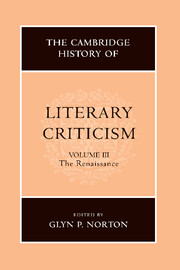Book contents
- Frontmatter
- Introduction
- READING AND INTERPRETATION: AN EMERGING DISCOURSE OF POETICS
- POETICS
- I Humanist classifications
- II The rediscovery and transmission of materials
- III Rhetorical poetics
- 13 Humanist education
- 14 Second rhetoric and the grands rhétoriqueurs
- 15 The rhetoric of presence: art, literature, and illusion
- 16 The paradoxical sisterhood: ‘ut pictura poesis’
- 17 Conceptions of style
- 18 Sir Philip Sidney's An apology for poetry
- 19 Aristotle, Horace, and Longinus: the conception of reader response
- IV Literary forms
- THEORIES OF PROSE FICTION
- CONTEXTS OF CRITICISM: METROPOLITAN CULTURE AND SOCIO-LITERARY ENVIRONMENTS
- VOICES OF DISSENT
- STRUCTURES OF THOUGHT
- NEOCLASSICAL ISSUES: BEAUTY, JUDGEMENT, PERSUASION, POLEMICS
- A SURVEY OF NATIONAL DEVELOPMENTS
- Bibliography
- Index
- References
17 - Conceptions of style
from III - Rhetorical poetics
Published online by Cambridge University Press: 28 March 2008
- Frontmatter
- Introduction
- READING AND INTERPRETATION: AN EMERGING DISCOURSE OF POETICS
- POETICS
- I Humanist classifications
- II The rediscovery and transmission of materials
- III Rhetorical poetics
- 13 Humanist education
- 14 Second rhetoric and the grands rhétoriqueurs
- 15 The rhetoric of presence: art, literature, and illusion
- 16 The paradoxical sisterhood: ‘ut pictura poesis’
- 17 Conceptions of style
- 18 Sir Philip Sidney's An apology for poetry
- 19 Aristotle, Horace, and Longinus: the conception of reader response
- IV Literary forms
- THEORIES OF PROSE FICTION
- CONTEXTS OF CRITICISM: METROPOLITAN CULTURE AND SOCIO-LITERARY ENVIRONMENTS
- VOICES OF DISSENT
- STRUCTURES OF THOUGHT
- NEOCLASSICAL ISSUES: BEAUTY, JUDGEMENT, PERSUASION, POLEMICS
- A SURVEY OF NATIONAL DEVELOPMENTS
- Bibliography
- Index
- References
Summary
Before the late seventeenth century, the language of criticism develops within the rhetorical tradition. Renaissance discussions of style accordingly centre on prose, a focus reflecting the cultural priority of the humanist paideia over vernacular poetry throughout the period. The fullest and most important of such discussions occur in the great scholarly neo-Latin rhetorics, although these subsequently inform vernacular rhetoric, as well as poetics, music theory, and art criticism. Because stylistic concepts evolve within the pan-European culture of neo-Latin humanism, it seems possible to sketch a general outline of Renaissance stylistics; yet because the cultural and political functions of these rhetorical categories shift from country to country, such an overview needs to be supplemented by consideration of specific national contexts. This chapter will therefore examine the dominant trends in Renaissance stylistics but also their divergent ideological exfoliation in France and England.
Renaissance terminology for stylistic analysis draws upon four principal categories, all borrowed from classical rhetoric. Style may be described in terms of (1) the genera dicendi – the Roman categories of low/plain, middle, and grand style (or their Greek equivalents); (2) its classical prototypes; for example, a style may be labelled as Senecan, Tacitean, or Ciceronian; (3) its characteristic features, especially syntactic; Renaissance rhetorics thus classify styles as periodic, curt, copious, laconic, pointed, loose; and (4) the related distinction between Attic (brief), Asiatic (copious), and Rhodian (intermediate) styles. These categories are not exclusive; one may describe an author as using an Asiatic middle style or pointed Senecan brevity. Nor are they unambiguous. In Renaissance (as in classical) rhetoric, for example, the plain style includes an informal conversational manner, the type of speech characteristic of ‘low’ persons, the unartistic plainness of logical/scholastic argument, and a graceful cultivated urbanity.
- Type
- Chapter
- Information
- The Cambridge History of Literary Criticism , pp. 176 - 186Publisher: Cambridge University PressPrint publication year: 1999
References
- 2
- Cited by

